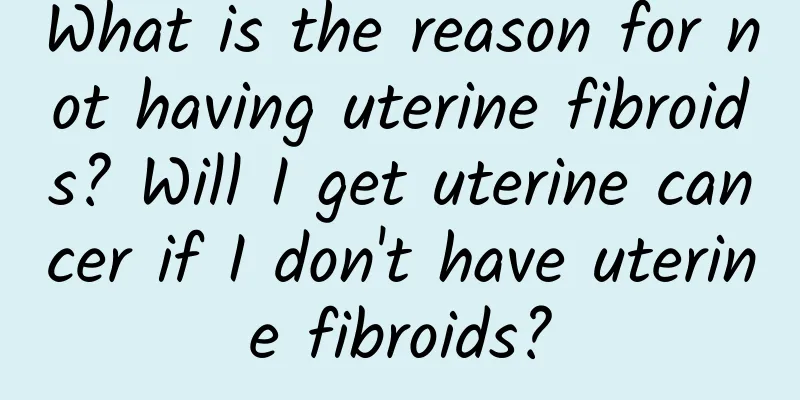What is the reason for not having uterine fibroids? Will I get uterine cancer if I don't have uterine fibroids?

|
What is the reason for not having uterine fibroids? This is a question in the minds of many female friends. Uterine fibroids are one of the most common benign tumors in the female reproductive system, usually growing inside the uterine wall. However, not every woman will suffer from uterine fibroids. So, what may be the reason for not having uterine fibroids? At the same time, can women without uterine fibroids get uterine cancer? Let's explore them one by one. There may be many reasons for not having uterine fibroids. The occurrence of uterine fibroids is related to changes in female hormone levels, especially estrogen levels. Estrogen is a type of female reproductive hormone that plays an important role in women's physiological processes. Different lifestyles and genetic factors may affect the level of estrogen in women, thereby increasing the risk of uterine fibroids. Some studies have found that factors such as lack of exercise, obesity and high blood pressure are related to the occurrence of uterine fibroids. Therefore, maintaining a healthy lifestyle and maintaining a proper weight may help prevent the occurrence of uterine fibroids. In addition, genetic factors may also affect the occurrence of uterine fibroids. Some studies have shown that women with a family history are more likely to develop uterine fibroids. This means that if a woman's mother or sister has uterine fibroids, then her risk of developing this tumor will increase. Therefore, genetic factors are also one of the reasons for not being able to develop uterine fibroids. Although the proportion of women without uterine fibroids is higher, it does not mean that they will not get uterine cancer. Uterine fibroids are benign tumors that usually do not turn into cancer. However, uterine fibroids themselves do not completely eliminate the risk of uterine cancer. In fact, studies have found that some patients with uterine fibroids also suffer from endometrial cancer, which is a common malignant tumor. Therefore, not having uterine fibroids does not mean that there is no risk of uterine cancer. To reduce the risk of uterine fibroids and uterine cancer, women need to take some preventive measures. First, it is important to maintain a healthy lifestyle. Regular physical exercise, maintaining a proper weight, and eating a balanced diet can help reduce the chances of developing uterine fibroids and uterine cancer. In addition, regular gynecological examinations are necessary. Regular examinations can help doctors detect and treat any potential problems, including uterine fibroids and uterine cancer, early. In summary, the absence of uterine fibroids can be due to many reasons, including lifestyle, genetic factors, etc. However, the absence of uterine fibroids does not mean that there is no risk of uterine cancer, because uterine fibroids themselves cannot completely rule out the possibility of cancer. Therefore, women should reduce the risk of uterine fibroids and uterine cancer by maintaining a healthy lifestyle and regular gynecological examinations. For those women who already have uterine fibroids, early treatment and regular follow-up are also very important. Through these measures, we can stay healthy, reduce the risk of disease, and live a happy and fulfilling life. |
<<: How to treat uterine fibroids? How to treat uterine fibroids?
Recommend
Who are the high-risk groups for cervical erosion?
In daily life, some women have a higher chance of...
Do multiple abortions lead to endometrial hyperplasia? How can women prevent endometrial hyperplasia?
Endometrial hyperplasia is mainly caused by repea...
How to use medicine to treat amenorrhea
How to use medicine to treat amenorrhea? If you a...
What should women do if they have cervical erosion and cysts? Treatment methods for patients with cervical erosion and cysts
Female patients with cervical erosion often face ...
Introduction to the classification of irregular menstruation in traditional Chinese medicine
Irregular menstruation is a gynecological disease...
The hazards of painless abortion are manifested in the following aspects
Painless abortion is very harmful to women. Women...
Does abortion require uterine curettage?
If the abortion is complete and the embryonic tis...
Five typical early symptoms of ectopic pregnancy
Ectopic pregnancy is a type of gynecological dise...
Eat a whole chicken for good luck! Chicken calories comparison, the first place is...
In response to the coming of the Year of the Roos...
Anti-inflammatory and surgical treatment of acute adnexitis
Adnexitis refers to inflammation of the fallopian...
Decoding: Common causes of dysmenorrhea in women
Many female friends will experience dysmenorrhea ...
Be careful of these reasons causing cervical erosion
What are the causes of cervical erosion? Cervical...
The harm of amenorrhea for many years to women
Amenorrhea for many years may cause serious harm ...
Bloggers love eating this way! Recipe for thin face (Part 2)
Ai Ai Wo, who is not fat, once tried the legendar...
Tomato sobering up? Nutritionist: Fruits and vegetables help restore liver function
Two major beverage manufacturers in Japan collabo...









